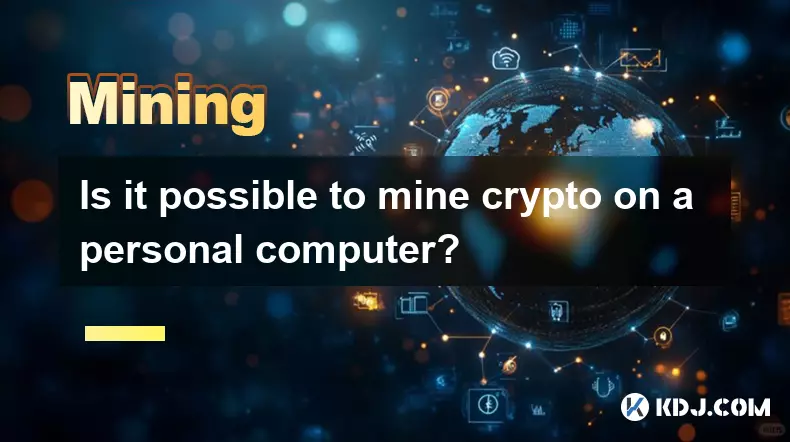-
 bitcoin
bitcoin $112715.707551 USD
-1.71% -
 ethereum
ethereum $4101.475385 USD
-3.01% -
 tether
tether $1.000644 USD
-0.02% -
 bnb
bnb $1207.619465 USD
-6.77% -
 xrp
xrp $2.501451 USD
-3.98% -
 solana
solana $202.947124 USD
-3.32% -
 usd-coin
usd-coin $1.000295 USD
0.04% -
 dogecoin
dogecoin $0.203884 USD
-4.47% -
 tron
tron $0.317154 USD
-1.72% -
 cardano
cardano $0.695009 USD
-4.43% -
 hyperliquid
hyperliquid $38.853961 USD
-8.23% -
 chainlink
chainlink $18.988674 USD
-4.64% -
 ethena-usde
ethena-usde $1.000233 USD
-0.03% -
 stellar
stellar $0.337050 USD
-3.63% -
 bitcoin-cash
bitcoin-cash $536.861728 USD
-1.28%
What is the cooling system of a mining machine?
Understanding a mining machine's cooling system, which includes fans, heat sinks, and sometimes liquid cooling, is crucial for efficient and profitable cryptocurrency mining.
Apr 11, 2025 at 03:42 am

Mining machines, used extensively in the cryptocurrency industry for mining operations, generate significant amounts of heat due to their high-performance components. To maintain optimal performance and longevity, these machines are equipped with sophisticated cooling systems. Understanding the cooling system of a mining machine is crucial for anyone involved in cryptocurrency mining, as it directly impacts the efficiency and profitability of mining operations.
Components of a Mining Machine Cooling System
The cooling system of a mining machine typically consists of several key components designed to dissipate heat effectively. The primary components include fans, heat sinks, and sometimes liquid cooling systems. Fans are the most common cooling method, installed to circulate air and remove heat from the machine's internal components. Heat sinks are attached to high-heat components like the GPU or ASIC chips to absorb and dissipate heat. In more advanced setups, liquid cooling systems may be used, which involve a coolant that circulates through the machine to absorb heat more efficiently than air.
How Fans Work in Mining Machine Cooling
Fans play a critical role in the cooling system of a mining machine. They are strategically placed to ensure optimal airflow through the machine. Typically, fans are positioned at the intake and exhaust points of the machine. Intake fans draw in cooler air from the environment, which then passes over the heat-generating components. Exhaust fans expel the теплый воздух, preventing it from recirculating and causing overheating. The number and size of fans can vary depending on the machine's design and the intensity of the mining operations.
The Role of Heat Sinks in Cooling
Heat sinks are another essential component of a mining machine's cooling system. They are typically made of materials with high thermal conductivity, such as aluminum or copper. Heat sinks work by absorbing heat from the components they are attached to and then dissipating it into the surrounding air. The design of heat sinks often includes fins to increase the surface area for better heat dissipation. In some mining machines, heat pipes may be used in conjunction with heat sinks to transfer heat more efficiently to a cooler area of the machine.
Liquid Cooling Systems in Mining Machines
For high-performance mining operations, some machines employ liquid cooling systems. These systems use a coolant, often a mixture of water and glycol, to absorb heat from the machine's components. The coolant circulates through a closed loop, passing over the hot components and then through a radiator where it releases the absorbed heat. Liquid cooling systems are more efficient than air cooling and can handle higher heat loads, making them ideal for intensive mining operations. However, they are also more complex and require regular maintenance to ensure they function correctly.
Maintenance and Optimization of Cooling Systems
Maintaining and optimizing the cooling system of a mining machine is vital for ensuring its longevity and efficiency. Regular cleaning of fans and heat sinks is essential to prevent dust buildup, which can impede airflow and reduce cooling efficiency. Here are some steps to maintain and optimize the cooling system:
- Clean the fans and heat sinks regularly: Use compressed air or a soft brush to remove dust and debris from the fans and heat sinks.
- Check and replace fans if necessary: Over time, fans can wear out or become less efficient. Monitor their performance and replace them if they are not functioning properly.
- Ensure proper ventilation: Make sure the mining machine is placed in a well-ventilated area to facilitate effective heat dissipation.
- Monitor temperatures: Use software tools to monitor the temperatures of your mining machine's components. If temperatures are consistently high, consider upgrading your cooling system.
- Consider upgrading to liquid cooling: If air cooling is not sufficient for your mining needs, consider investing in a liquid cooling system for better performance.
Impact of Cooling Systems on Mining Efficiency
The efficiency of a mining machine's cooling system directly affects its overall performance and profitability. A well-maintained cooling system ensures that the machine can operate at optimal speeds without overheating. Overheating can lead to thermal throttling, where the machine reduces its performance to prevent damage, which in turn reduces mining efficiency. By maintaining an effective cooling system, miners can maximize their hash rates and, consequently, their cryptocurrency earnings.
Frequently Asked Questions
Q: Can I use a regular computer fan to cool my mining machine?A: While it is technically possible to use a regular computer fan, it may not be sufficient for the high heat output of a mining machine. Mining machines often require more powerful and larger fans designed specifically for high-performance cooling.
Q: How often should I clean the cooling system of my mining machine?A: It is recommended to clean the cooling system of your mining machine at least once every three months. However, if you are operating in a dusty environment, you may need to clean it more frequently.
Q: Is it worth investing in a liquid cooling system for my mining machine?A: If you are running intensive mining operations and your current cooling system is struggling to keep up, investing in a liquid cooling system can be worthwhile. Liquid cooling systems are more efficient and can handle higher heat loads, potentially improving your mining efficiency and profitability.
Q: Can overheating damage my mining machine permanently?A: Yes, overheating can cause permanent damage to the components of your mining machine. Prolonged exposure to high temperatures can lead to component failure, reducing the lifespan and performance of your machine.
Disclaimer:info@kdj.com
The information provided is not trading advice. kdj.com does not assume any responsibility for any investments made based on the information provided in this article. Cryptocurrencies are highly volatile and it is highly recommended that you invest with caution after thorough research!
If you believe that the content used on this website infringes your copyright, please contact us immediately (info@kdj.com) and we will delete it promptly.
- XRP, Dogecoin, and Ozak AI: A New York Minute on Crypto's Hottest Plays
- 2025-10-15 16:25:14
- CRDB Tokenisation Service: Revolutionizing Finance in Tanzania and Beyond
- 2025-10-15 16:25:14
- Alvara Protocol Mainnet Launch: ERC-7621 Token Revolutionizes DeFi
- 2025-10-15 16:30:01
- Bitcoin, Gold, and Silver: Safe Haven Showdown in 2025
- 2025-10-15 16:30:01
- Sei Price Wobbles: Token Unlock Jitters Meet Downside Risk – A Trader's Guide
- 2025-10-15 16:45:12
- Peter Brandt, Bitcoin, and Investor Predictions: Navigating the Crypto Seas
- 2025-10-15 16:30:01
Related knowledge

Is it possible to mine crypto on a personal computer?
Oct 14,2025 at 08:18pm
Can You Mine Cryptocurrency Using a Personal Computer?1. Yes, it is technically possible to mine cryptocurrency on a personal computer. Early in the h...

The difference between staking and mining
Sep 24,2025 at 05:18am
Understanding Staking in the Cryptocurrency Ecosystem1. Staking involves holding funds in a cryptocurrency wallet to support the operations of a block...

How to participate in testnet mining?
Sep 22,2025 at 09:18am
Understanding Testnet Mining in the Crypto Ecosystem1. Testnet mining is a method used by blockchain developers to simulate real-world conditions on a...

How to dispose of abandoned mining machines?
Sep 19,2025 at 08:19pm
Assessing the Condition of Abandoned Mining Rigs1. Begin by inspecting each mining machine for visible damage, corrosion, or missing components. Machi...

How to identify high-quality mining pools?
Sep 21,2025 at 03:19pm
Reputation and Track Record1. A mining pool’s reputation is built over time through consistent performance and transparency. Pools that have operated ...

Advantages of decentralized mining pools
Sep 20,2025 at 04:36pm
Enhanced Security and Resistance to Censorship1. Decentralized mining pools operate on blockchain-based smart contracts, eliminating the need for a ce...

Is it possible to mine crypto on a personal computer?
Oct 14,2025 at 08:18pm
Can You Mine Cryptocurrency Using a Personal Computer?1. Yes, it is technically possible to mine cryptocurrency on a personal computer. Early in the h...

The difference between staking and mining
Sep 24,2025 at 05:18am
Understanding Staking in the Cryptocurrency Ecosystem1. Staking involves holding funds in a cryptocurrency wallet to support the operations of a block...

How to participate in testnet mining?
Sep 22,2025 at 09:18am
Understanding Testnet Mining in the Crypto Ecosystem1. Testnet mining is a method used by blockchain developers to simulate real-world conditions on a...

How to dispose of abandoned mining machines?
Sep 19,2025 at 08:19pm
Assessing the Condition of Abandoned Mining Rigs1. Begin by inspecting each mining machine for visible damage, corrosion, or missing components. Machi...

How to identify high-quality mining pools?
Sep 21,2025 at 03:19pm
Reputation and Track Record1. A mining pool’s reputation is built over time through consistent performance and transparency. Pools that have operated ...

Advantages of decentralized mining pools
Sep 20,2025 at 04:36pm
Enhanced Security and Resistance to Censorship1. Decentralized mining pools operate on blockchain-based smart contracts, eliminating the need for a ce...
See all articles


























![Staking ATH: How To Stake $ATH in October 2025 with 523% APY — [Step-By-Step Guide] Staking ATH: How To Stake $ATH in October 2025 with 523% APY — [Step-By-Step Guide]](/uploads/2025/10/15/cryptocurrencies-news/videos/staking-ath-stake-ath-october-apy-stepstep-guide/68eef94d80903_image_500_375.webp)















































